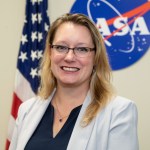As branch chief of the Hypervelocity Impact and Orbital Debris Office at NASA’s Johnson Space Center in Houston, Dr. Heather Cowardin leads a team tasked with a critical mission: characterizing and mitigating orbital debris—space junk that poses a growing risk to satellites, spacecraft, and human spaceflight.
Long before Cowardin was a scientist safeguarding NASA’s mission, she was a young girl near Johnson dreaming of becoming an astronaut.
“I remember driving down Space Center Boulevard with my mom and seeing people running on the trails,” she said. “I told her, ‘That will be me one day—I promise!’ And she always said, ‘I know, honey—I know you will.’”

Heather Cowardin
Hypervelocity Impact and Orbital Debris Branch Chief
Today, that childhood vision has evolved into a leadership role at the heart of NASA’s orbital debris research. Cowardin oversees an interdisciplinary team within the Astromaterials Research and Exploration Science Division, or ARES. She supports measurements, modeling, risk assessments, and mitigation strategies to ensure the efficiency of space operations.
With more than two decades of experience, Cowardin brings expertise and unwavering dedication to one of the agency’s most vital safety initiatives.
Her work focuses on characterizing Earth-orbiting objects using optical and near-infrared telescopic and laboratory data. She helped establish and lead the Optical Measurement Center, a specialized facility at Johnson that replicates space-like lighting conditions and telescope orientations to identify debris materials and shapes, and evaluate potential risk.
Cowardin supports a range of research efforts, from ground-based and in-situ, or in position, observations to space-based experiments. She has contributed to more than 100 scientific publications and presentations and serves as co-lead on Materials International Space Station Experiment missions, which test the durability of materials on the exterior of the orbiting laboratory.
She is also an active member of the Inter-Agency Space Debris Coordination Committee, an international forum with the goal of minimizing and mitigating the risks posed by space debris.
Her passion was fueled further by a mentor, Dr. James R. Benbrook, a University of Houston space physics professor and radar scientist supporting the Orbital Debris Program Office. “He was a hard-core Texas cowboy and a brilliant physicist,” she said. “He brought me on as a NASA fellow to study orbital debris using optical imaging. After that, I was committed to working at NASA—no matter what it took.”
After completing her fellowship, Cowardin began graduate studies at the University of Houston while working full time. Within a year, she accepted a contract position at Johnson, where she helped develop the Optical Measurement Center and supported optical analyses of geosynchronous orbital debris. She soon advanced to optical lead, later serving as a contract project manager and section manager.

Heather Cowardin
Hypervelocity Impact and Orbital Debris Branch Chief
Building on her growing expertise, Cowardin became the laboratory and in-situ measurements lead for the Orbital Debris Program Office, a program within the Office of Safety and Mission Assurance at NASA Headquarters. She led efforts to characterize debris and deliver direct measurement data to support orbital debris engineering models, such as NASA’s Orbital Debris Engineering Model and NASA’s Standard Satellite Breakup Model, while also overseeing major projects like DebriSat.
Cowardin was selected as the Orbital Debris and Hypervelocity Integration portfolio scientist, where she facilitated collaboration within the Hypervelocity Impact and Orbital Debris Office—both internally and externally with stakeholders and customers. These efforts laid the foundation for her current role as branch chief.
“I’ve really enjoyed reflecting on the path I’ve traveled and looking forward to the challenges and successes that lie ahead with this great team,” she said.
One of Cowardin’s proudest accomplishments was earning her doctorate while working full time and in her final trimester of pregnancy.
“Nothing speaks to multitasking and time management like that achievement,” Cowardin said. “I use that story to mentor others—it’s proof that you can do both. Now I’m a mom of two boys who inspire me every day. They are my motivation to work harder and show them that dedication and perseverance always pay off.”
Throughout her career, Cowardin said one lesson has remained constant: never underestimate yourself.
“It’s easy to think, ‘I’m not ready,’ or ‘Someone else will ask the question,’” she said. “But speak up. Every role I’ve taken on felt like a leap, but I embraced it and each time I’ve learned and grown.”
She has also learned the value of self-awareness. “It’s scary to ask for feedback, but it’s the best way to identify growth opportunities,” she said. “The next generation will build on today’s work. That’s why we must capture lessons learned and share them. It’s vital to safe and successful operations.”
To the Artemis Generation, she hopes to pass on a sense of purpose.
“Commitment to a mission leads to success,” she said. “Even if your contributions aren’t immediately visible, they matter. What we do at NASA takes new thinking, new skills, and hard work—but I believe the next generation will raise the bar and lead us beyond low Earth orbit.”
When she is not watching over orbital debris, she is lacing up her running shoes.
“I’ve completed five half-marathons and I’m training for the 2026 Rock ‘n’ Roll half-marathon in Nashville,” she said. “Running helps me decompress—and yes, I often role-play technical briefings or prep conference talks while I’m out on a jog. Makes for interesting moments when I pass people in the neighborhood!”


